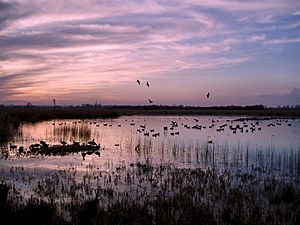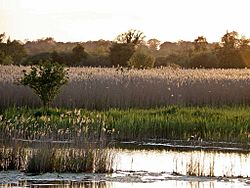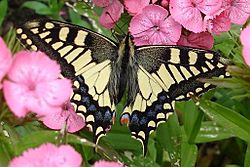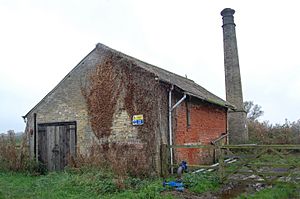Strumpshaw Fen RSPB reserve facts for kids
Quick facts for kids RSPB Strumpshaw Fen |
|
|---|---|

A view from the Reception Hide over water showing mostly greylag goose (Anser anser) coming into land for the evening.
|
|
| Type | Nature reserve |
| Location | Norfolk, England |
| Operated by | RSPB |
| Public transit access | Brundall railway station |
Strumpshaw Fen is a special nature reserve in Norfolk, England. It's managed by the Royal Society for the Protection of Birds (RSPB), a group that helps protect wildlife. You can find it near the River Yare, about 6 miles (10 km) east of Norwich.
This reserve is part of a bigger area called the Mid-Yare National Nature Reserve. The RSPB bought Strumpshaw Fen in 1974 to protect its unique plants and animals. It's also part of a very important natural area known as The Broads.
Discover the Wildlife at Strumpshaw Fen
Birds: Feathered Friends of the Fen
Strumpshaw Fen is a fantastic place for birdwatching! Many different kinds of birds live here all year round. Others visit for the summer or winter.
Birds You Can See All Year
- Eurasian bittern: These birds are hard to spot because they hide well. But in spring, you might hear the male's loud "booming" call.
- Common kingfisher: Look for their bright blue and orange feathers as they zip across the water. You might see them carrying fish to their nests.
- Marsh harrier: These birds of prey often fly high in the sky. In spring, pairs do amazing "sky-dancing" displays.
- Cetti's warbler: This tiny bird has one of the loudest songs in Britain! Once you learn it, you'll recognize its "explosive" sound.
- Bearded tit: These small birds have unique "moustaches."
- Barn owl: You might see these beautiful owls hunting at dawn or dusk. They often nest in the woodlands.
- Eurasian bullfinches: Look for their bright colors.
Water Birds
You'll also find many water birds, including:
Birds That Visit in Summer
Some birds fly to Strumpshaw Fen for the warmer months:
- Hobby
- Reed warbler
- Blackcap
- Whitethroat
Birds That Visit in Winter
In autumn, many birds migrate to the reserve. Some are heading south, while others come from the Arctic to escape the cold.
- Hen harrier: These birds are often seen in winter.
- Sometimes, Waxwings visit from Scandinavia looking for food.
Insects: Tiny Creatures, Big Impact
Strumpshaw Fen is one of the few places in Great Britain where the amazing swallowtail butterfly lives and breeds. The type found here, Papilio machaon brittanicus, is special. It's a bit smaller than other swallowtails in Europe. These butterflies usually lay their eggs on a plant called milk parsley. You can often see them flying from late May to mid-July, and sometimes again in August or September. They are the biggest butterflies in Britain, with wingspans of 8 to 10 cm!
The reserve is also home to 23 types of dragonfly. This includes the rare Norfolk hawker, which is an endangered insect. Another important dragonfly here is the scarce chaser.
Molluscs: Snails and More
One special snail found here is the Desmoulin's whorl snail. It's on the list of endangered species in the British Isles.
Plants: Green Wonders of the Fen
Strumpshaw Fen has many rare and important plants.
- One very rare plant is the holly-leaved naiad. It's protected by law because it's so endangered.
- Other important plants include milk parsley, marsh pea, and saw sedge.
- You can also find six different kinds of orchids here!
The reserve has a special hay meadow. This meadow has been cut for hay in the same way for hundreds of years. This old practice helps many different plants grow there.
- In June, you'll see bright yellow flag flowers, marsh cinquefoil, bog bean, and ragged robin. These flowers provide nectar for the swallowtail butterflies.
- In early July, you'll find common sorrel, Yorkshire fog, southern marsh orchids, yellow rattle, and valerian.
- Later, purple loosestrife and meadowsweet bloom.
Mammals: Furry Residents
Keep an eye out for these mammals:
- Eurasian otters: These playful animals live in the waterways.
- Water voles: Small rodents that live near water.
- Chinese water deer: These deer are quite unique.
Seasonal Changes at the Reserve
Winter: A Chilly Wonderland
- Hundreds of ducks, like teals, gadwalls, and shovelers, gather in the reedbed pools to feed.
- As evening approaches, marsh and hen harriers come together to roost.
- Sometimes, thousands of starlings roost in the reeds. This attracts birds of prey like sparrowhawks and peregrines.
Spring: New Life and Sounds
- Courting marsh harriers perform amazing "sky-dancing" displays.
- You'll hear the songs of many spring migrant birds. These include reed and sedge warblers, cuckoos, and grasshopper warblers.
- Swallows and swifts dart over the water.
- Great crested grebes and other water birds start building their nests.
- You can hear lesser spotted and great spotted woodpeckers drumming in the woodlands.
- The loud "booming" calls of bitterns can be heard across the reserve.
Summer: Butterflies and Blooms
- The rare swallowtail butterfly emerges. You can see them flying from late May through July.
- The fen meadow is full of colorful flowers, including six types of orchids.
- Many butterflies, dragonflies, and damselflies are active.
- Hobby birds hunt dragonflies in the sky.
Autumn: Migrating Visitors
- Ospreys stop here to fish as they migrate south.
- Marsh harriers gather in groups to roost.
- Bearded tits form flocks in the reedbeds.
How the Reserve is Cared For

Strumpshaw Fen has different types of natural areas. These include reed beds, wet grasslands, woodlands, and flower-rich meadows. The River Yare also runs through it.
The RSPB uses traditional methods to look after these habitats. This includes cutting reeds, mowing grass, letting cattle graze, and removing unwanted plants.
When the RSPB bought the reserve in 1976, it was very overgrown. Since then, a lot of work has been done to bring it back to how it looked in the 1800s. This involved clearing plants and mud to create open water areas. Today, they continue to remove unwanted plants and fix old ditches.
They manage the reed beds and meadows by mowing and grazing in summer. They also control water levels and clear rushes. Wet woodlands are managed by protecting dead trees and keeping water levels high from April to July.
The reserve has the largest area of hay meadow in East Anglia that has been managed in the same way for centuries. This is very important for keeping its many different plants healthy.
Visitor Information
Strumpshaw Fen has several hides (places to watch wildlife from) and many walking trails.
The reserve is open every day from dawn until dusk, except on Christmas Day. There is a small entrance fee for visitors, but RSPB members can enter for free. After rain or river flooding, some parts of the trails can get muddy. So, it's a good idea to wear walking boots!
The Old Pumping House
Long ago, in the 1700s, a wind pump was used to drain the water from the fens at Strumpshaw. In the late 1800s, a steam-powered pump replaced it. You can still see the old brick engine house and its tall chimney by the river. Today, electric pumps are used to manage the water levels.



